

Stone Age humans used personal ornaments to communicate about themselves. Anthropologists say humans have been using personal ornaments to communicate about themselves without the fuss of conversation – for millennia.
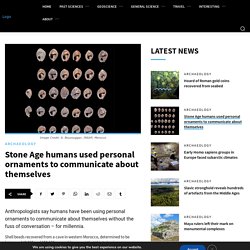
Shell beads recovered from a cave in western Morocco, determined to be between 142,000 and 150,000 years old, suggest that this behaviour may go back much farther than previously thought. The finding, detailed Wednesday in the journal Science Advances, was made by a team of archaeologists that includes Steven L. Neanderthal blood study hints at one possible reason they went extinct. In 1901, biologist Karl Landsteiner made a landmark discovery: Human blood contains different types of groups.

This finding led to a Nobel Prize and the eventual discovery of the four specific blood types: A, B, O, and AB. Today, more than a century later, Landsteiner‘s discovery is why millions of people receive life-saving blood transfusions. But more peculiarly, it’s allowed for an unprecedented look into the lives, and eventual demise, of ancient humans. Scientists recently analyzed the blood types of the Denisovans and Neanderthals, two now extinct members of our genus. In a study published Wednesday in the journal PLOS One, they claim the analysis points to new clues about the origin of these humans, their health, and how their genetics influence people alive today. These include insight into early interbreeding with Homo sapiens, a previously unknown genetic link to modern humans, and evidence of a genetic disease that may have hampered reproductive success. Scientists Find Oldest Evidence of Ancient Human Activity Deep Inside a Desert Cave.
The Wonderwerk Cave site in South Africa is one of very few places on Earth where human activity can be traced back continuously across millennia, and scientists just established the oldest evidence of archaic human habitation in the cave: some 1.8 million years ago.
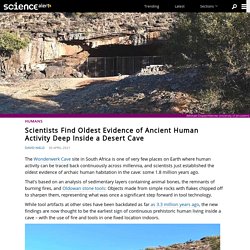
That's based on an analysis of sedimentary layers containing animal bones, the remnants of burning fires, and Oldowan stone tools: Objects made from simple rocks with flakes chipped off to sharpen them, representing what was once a significant step forward in tool technology. While tool artifacts at other sites have been backdated as far as 3.3 million years ago, the new findings are now thought to be the earliest sign of continuous prehistoric human living inside a cave – with the use of fire and tools in one fixed location indoors.
List of first human settlements. Wikimedia list article This is a list of dates associated with the prehistoric peopling of the world (first known presence of Homo sapiens).
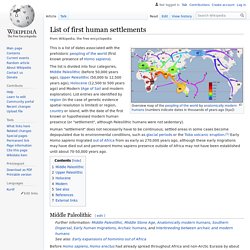
The list is divided into four categories, Middle Paleolithic (before 50,000 years ago), Upper Paleolithic (50,000 to 12,500 years ago), Holocene (12,500 to 500 years ago) and Modern (Age of Sail and modern exploration). List entries are identified by region (in the case of genetic evidence spatial resolution is limited) or region, country or island, with the date of the first known or hypothesised modern human presence (or "settlement", although Paleolithic humans were not sedentary). Early human migrations. The spread of humans from Africa through the world Putative migration waves out of Africa and back migrations into the continent, as well as the locations of major ancient human remains and archeological sites (López et al.2015).
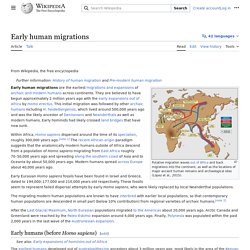
Early human migrations are the earliest migrations and expansions of archaic and modern humans across continents. New prehistoric human unknown to science discovered in Israel. When the researchers understood that the bones they had retrieved did not belong to either a Neanderthal or a Homo sapiens, they started to examine the possibility that they belonged to the last survivors of a more archaic population that they thought had become extinct hundreds of thousands of years earlier.
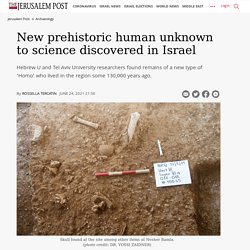
“We started to look for other members of this population, and we discovered that some fossils previously unearthed at other prehistoric sites in Israel, including the Qesem cave, belonged to the same group,” Hershkovitz said. “We therefore realized that we were dealing with a huge population that lived in the region, and probably also migrated in different directions, including in Asia and in Europe and later became the humans we know as Neanderthal.” Dinosaur-Destroying Asteroid Gave Rise to Modern Rainforests. It began with an Earth-shattering bang, and when the dust had settled, the dinosaurs were dead.
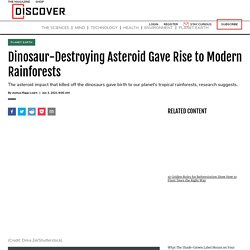
In fact, 75 percent of all life went extinct. Many of the organisms that did survive the initial impact of the Chicxulub asteroid died out in the following decades as our environment and climate underwent a series of extreme changes. The globe would never be the same again. Ancient genomes offer rare glimpse of Neanderthal family groups. More than 49,000 years ago, a family of Neanderthals set up camp in a cave high in Siberia’s Altai Mountains, overlooking a river valley where bison, red deer, and wild horses roamed.
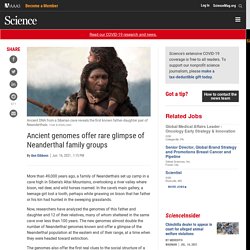
In the cave’s main gallery, a teenage girl lost a tooth, perhaps while gnawing on bison that her father or his kin had hunted in the sweeping grasslands. Now, researchers have analyzed the genomes of this father and daughter and 12 of their relatives, many of whom sheltered in the same cave over less than 100 years. The new genomes almost double the number of Neanderthal genomes known and offer a glimpse of the Neanderthal population at the eastern end of their range, at a time when they were headed toward extinction. The genomes also offer the first real clues to the social structure of a group of Neanderthals.
“It’s really remarkable that they managed to get genomes from seven males at one site,” says paleogeneticist Cosimo Posth at Tübingen University. To Skov, the evidence suggests the latter. Climate conditions during the migration of Homo sapiens out of Africa reconstructed. An international research team led by Professor Dr Frank Schäbitz has published a climate reconstruction of the last 200,000 years for Ethiopia.

This means that high-resolution data are now available for the period when early Homo sapiens, our ancestors, made their way from Africa to Europe and Asia. Schäbitz and his colleagues determined the dates using a drill core of lake sediments deposited in southern Ethiopia’s Chew Bahir Basin, which lies near human fossil sites. Temporal resolution of the samples, reaching nearly 10 years, revealed that from 200,000 to 125,000 years before our time, the climate there was relatively wet, providing enough water and thus abundant plant and animal food resources in the lowlands of East Africa. From 125,000 to 60,000 years ago, it gradually became drier, and particularly dry between 60,000 to 14,000 years ago. Header Image Credit : Public Domain. Neanderthals carb loaded, helping grow their big brains.
Here’s another blow to the popular image of Neanderthals as brutish meat eaters: A new study of bacteria collected from Neanderthal teeth shows that our close cousins ate so many roots, nuts, or other starchy foods that they dramatically altered the type of bacteria in their mouths.

The finding suggests our ancestors had adapted to eating lots of starch by at least 600,000 years ago—about the same time as they needed more sugars to fuel a big expansion of their brains. The study is “groundbreaking,” says Harvard University evolutionary biologist Rachel Carmody, who was not part of the research. The work suggests the ancestors of both humans and Neanderthals were cooking lots of starchy foods at least 600,000 years ago. And they had already adapted to eating more starchy plants long before the invention of agriculture 10,000 years ago, she says.
The brains of our ancestors doubled in size between 2 million and 700,000 years ago. Sex between humans and Neanderthals was way more common than realized. Thousands of years ago, the lives of two different species of humans were forever changed by two distinctly different events. During the Middle to Upper Palaeolithic transition, anatomically modern humans — Homo sapiens (that’s us) — started to migrate across Eurasia.
Neanderthals, meanwhile, started to disappear. “For a very long time, it has been intensively debated on how these processes exactly occurred,” Mateja Hajdinjak tells Inverse. Hajdinjak is an associate researcher at the Max Planck Institute for Evolutionary Anthropology and an expert in ancient genomics. A study co-authored by Hajdinjak and published Wednesday in the journal Nature — alongside another ancient humans study also published Wednesday in Nature — finally provides much-needed insight into what happened nearly 45,000 to 35,000 years ago. Stone Age culture bloomed inland, not just along Africa’s coasts.
Africa’s southern Kalahari Desert is not typically regarded as a hotbed of Stone Age innovations. And yet human culture blossomed there around 105,000 years ago, back when it was green, researchers say. Calcite crystals and other finds at a South African rock-shelter more than 600 kilometers from the nearest shoreline reflect cultural behaviors on a par with those previously reported for ancient humans living on or near South Africa’s coast, researchers report March 31 in Nature. The World's Earliest Stone Technologies Likely Older Than Previously Thought. (the “Website”), is operated by HERITAGEDAILY What are cookies? Cookies are small text files that are stored in the web browser that allows HERITAGEDAILY or a third party to recognise you. Neanderthals Used Toothpicks, New Research Reveals.
Analysing two teeth excavated from the Pleistocene layers of the Stajnia Cave (Kraków-Częstochowa Upland), the team led by Dr. Wioletta Nowaczewska from the Department of Human Biology, University of Wrocław, found traces left by a toothpick. She said: “It appears that the owner of the tooth used oral hygiene. Probably between the last two teeth there were food residues that had to be removed. We don’t know what he made a toothpick from – a piece of a twig, a piece of bone or fish bone. It had to be fairly stiff, cylindrical object, which the individual used often enough to leave a clear trace.” Did Cavemen Ever Really Exist? Kurzgesagt and John Green Look at The Human Condition Revealed Through Cave Paintings. When did the last Neanderthal die? New study changes the timeline. Nearly two centuries after Dutch naturalist Philippe-Charles Schmerling discovered the first Neanderthal fossil in 1829, we’re still trying to piece together the puzzle of our ancient kin.
One of the most hotly-debated topics in the field of ancient history is the disappearance of the Neanderthals. Exactly when these ancient humans went extinct is contested. New-found oldest primate ancestor watched the dinosaurs die. It's time to update the primate family tree — again. Neanderthals' Faecal Sediments Reveals How Gut Microbiota Benefits Our Health. Humans were drinking milk before they could digest it. Our history with milk presents a chicken-or-egg conundrum: Humans couldn’t digest the beverage before they evolved mutations that helped them do so, yet they had to already be consuming milk to change their DNA. First People to Enter the Americas Likely Did so With Their Dogs. The first people to settle in the Americas likely brought their own canine companions with them, according to new research which sheds more light on the origin of dogs.
These Early Humans Lived 300,000 Years Ago—But Had Modern Faces. Here's what we know sex with Neanderthals was like - BBC Future. Neanderthal anatomy. Excess protein enabled dog domestication during severe Ice Age winters. Sharing Leftover Meat May Have Contributed to Early Dog Domestication. Neanderthal DNA discovery solves a human history mystery. For what felt like forever, evolutionary researchers were frustrated: They simply could not find the Neanderthal Y chromosome — there were just no good samples to be found. The Y chromosome is only possessed by males, passed exclusively from father to son. Neanderthals vs. Homo sapiens: Inside the 100,000-year-long battle for supremacy.
Earliest humans stayed at the Americas ‘oldest hotel’ in Mexican cave. “By the time the famous Clovis population entered America, the very early Americans had disappeared thousands of years before” Neanderthal gene linked to increased pain sensitivity. First North Americans Arrived Earlier Than Thought. Ancient Feces Study Shows What Parasites Plagued Human Ancestors. Heightened interaction between neolithic migrants and hunter-gatherers in Western Europe. Prehistoric human footprints reveal a rare snapshot of ancient human group behavior. Remains in Bulgarian cave may be from earliest known humans in Europe. Explorers in Antarctica find the fossils of a "totally unexpected" animal.
Man Finds A 12-Million-Year-Old Crab Fossil And Frees The Crab From Sediment In Stunning Time Lapse. A hominid transition occurred in southern Africa 2 million years ago. Ancient humans procreated with at least four other species. Mystery of where early Earth’s life-fuelling phosphates came from may have been solved. Early humans in Africa may have interbred with a mysterious, extinct species – new research. Earliest interbreeding event between ancient human populations discovered. Mysterious ‘ghost’ populations had multiple trysts with human ancestors. 1000 Genomes. Were Neanderthals more than cousins to Homo sapiens? - Attention to the Unseen. Artificial intelligence to study the behavior of Neanderthals. A gene tied to facial development hints humans self-domesticated.
Early humans domesticated themselves, new genetic evidence suggests. The finding of the oldest human skull changes evolution science. Apidima 1 Is the Oldest Human Fossil Outside Africa. New fossils suggest humans evolved in Europe, not Africa. Here's the Evolution of Humans Told from a Gamer's Perspective. Was There a Civilization On Earth Before Humans? Do humans have a 'ghost' ancestor? Artificial intelligence thinks so. Research suggests life thrived on Earth 3.5 billion years ago. This cave sheltered some of the first known humans 300,000 years ago. A surprisingly early replacement of Neanderthals by modern humans in southern Spain. A New Thermodynamics Theory of the Origin of Life.
NASA experiment shows DNA sugars could be floating around in space. Death near the shoreline, not life on land. Peering into Little Foot's 3.67 million-year-old brain. Looking for LUCA, the Last Universal Common Ancestor. Rethinking the history related to indigenous sites in northeast North America. The whole of Africa was the cradle of Humankind. The Human Origin Story Has Changed Again, Thanks to New Discovery in Algeria. Oldest-known ancestor of modern primates may have come from North America, not Asia. Humans and Neanderthals were frequent lovers, genetics. Sciencemag. Study reconstructs Neandertal ribcage, offers new clues to ancient human anatomy. Mysterious fossil footprints may cast doubt on human evolution timeline. 700,000-Year-Old Stone Tools Point to Mysterious Human Relative. More than half your body is not human.
Gizmodo. Humans May Have Occupied North America 100,000 Years Earlier Than Thought. Oldest Human Footprints in North America Discovered: Here's What They Reveal. A Twist in Humans' Sexual Encounters With Denisovans. Humans bred with this mysterious species more than once, new study shows. Radical Revision To Timeline Of Human Behavior Evolution - Dead Things : Dead Things. Genetic prehistory of Iberia differs from central and northern Europe. Sciencemag. Homo erectus may have been a sailor – and able to speak.
Oldest Human Fossils Outside Africa Push Back Our Timeline...Again - Dead Things : Dead Things. Theconversation. The Origin of "Us": What we know so far about where humans come from. Common Ancestor of Sharks and Humans Lived 440 Million Years Ago. Gizmodo. Mammals switched to daytime activity after dinosaur extinction - HeritageDaily - Heritage & Archaeology News. The Contribution of Neanderthals to Phenotypic Variation in Modern Humans: The American Journal of Human Genetics. You Might Be a Neanderthal If... Stone Age child reveals that modern humans emerged more than 300,000 years ago - HeritageDaily - Heritage & Archaeology News. Neanderthal brains 'grew more slowly'
Our controversial footprint discovery suggests human-like creatures may have roamed Crete nearly 6m years ago. Sciencemag. Neanderthals were distilling tar 200 thousand years ago in Europe. Mysterious fossil footprints may cast doubt on human evolution timeline. Sciencemag. New look at archaic DNA rewrites human evolution story - HeritageDaily - Heritage & Archaeology News. Fossil tooth pushes back record of mysterious Neandertal relative.
Neandertals and modern humans started mating early. Scientists find 7.2-million-year-old pre-human remains in the Balkans.